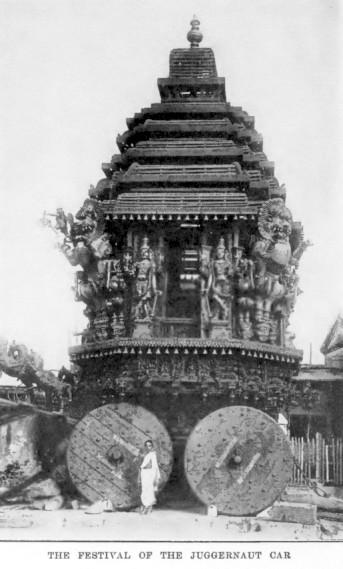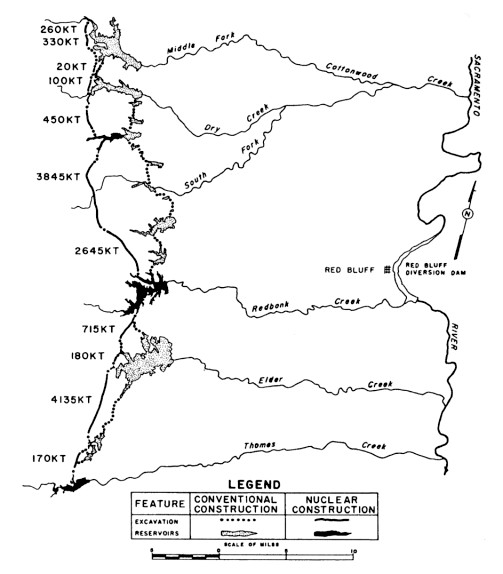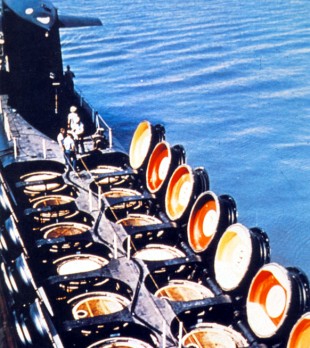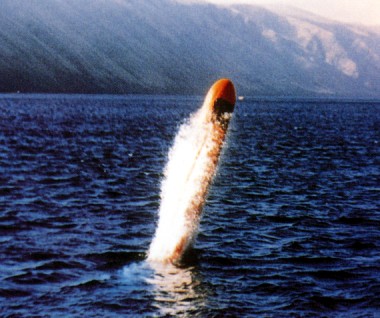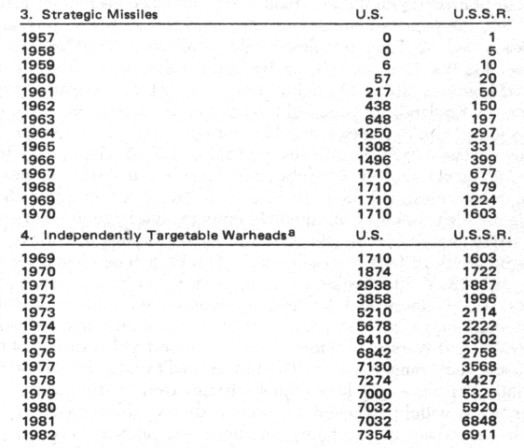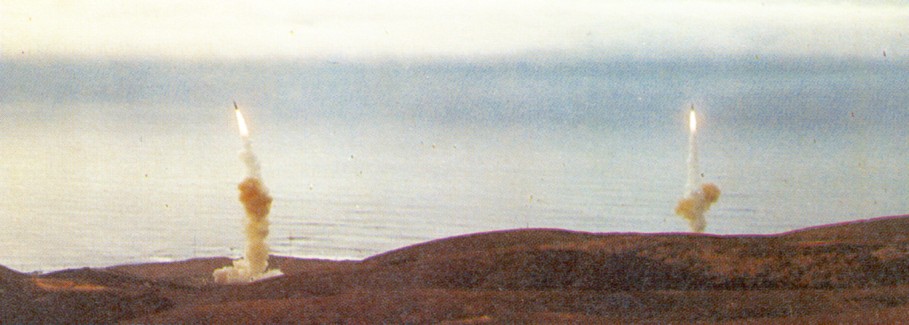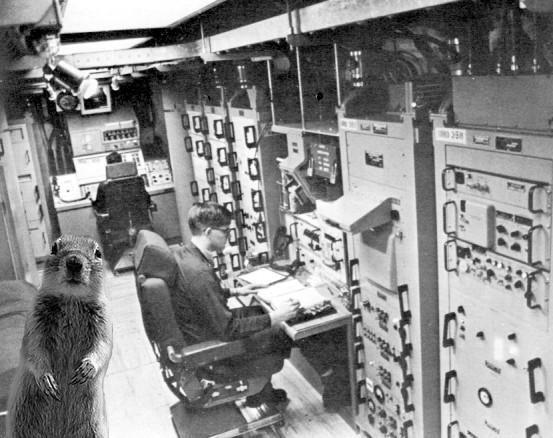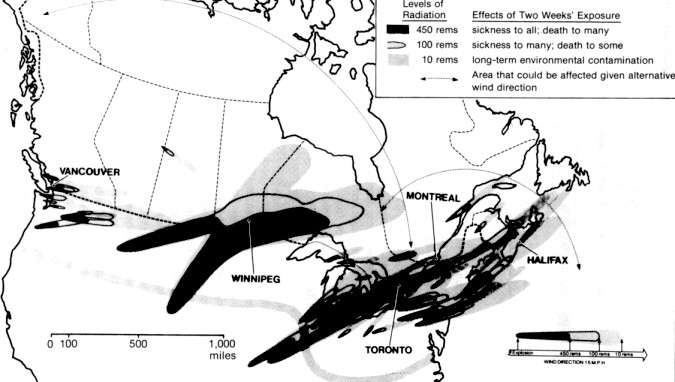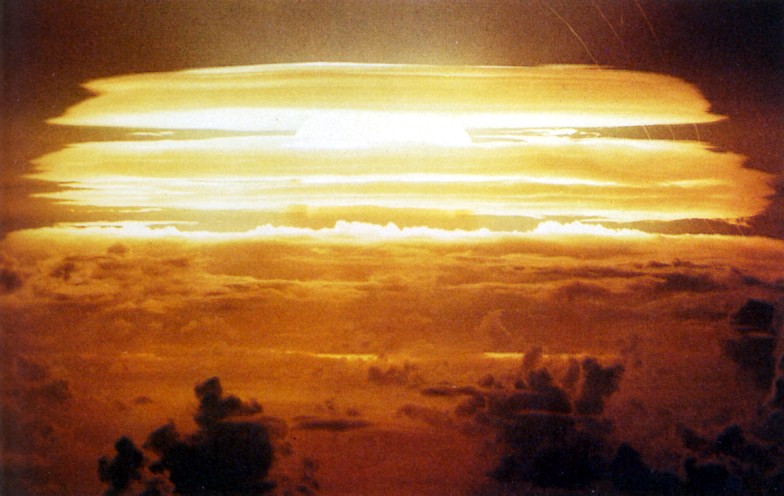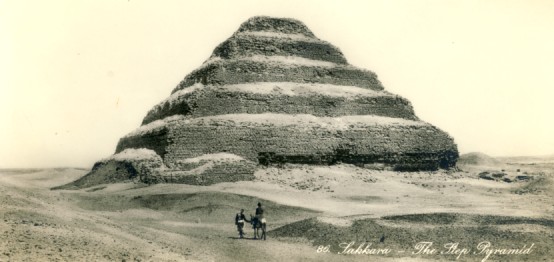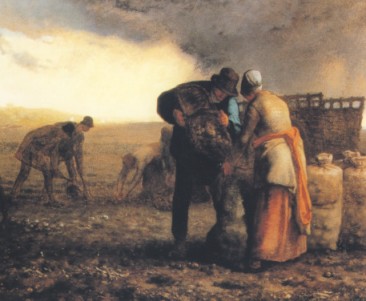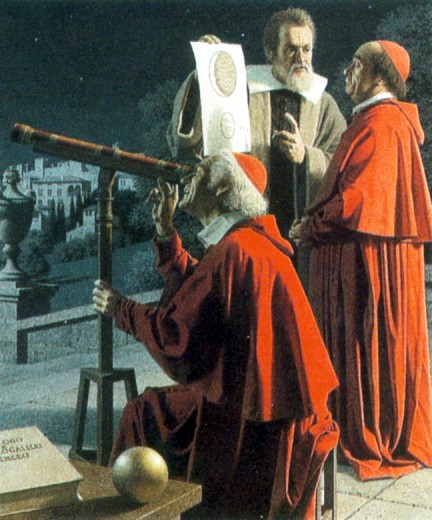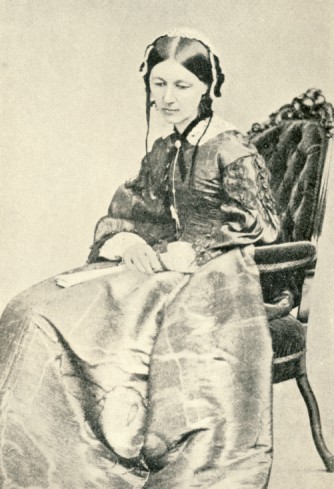1950s
The Consolidated Vultee B-36
'Peacemaker'
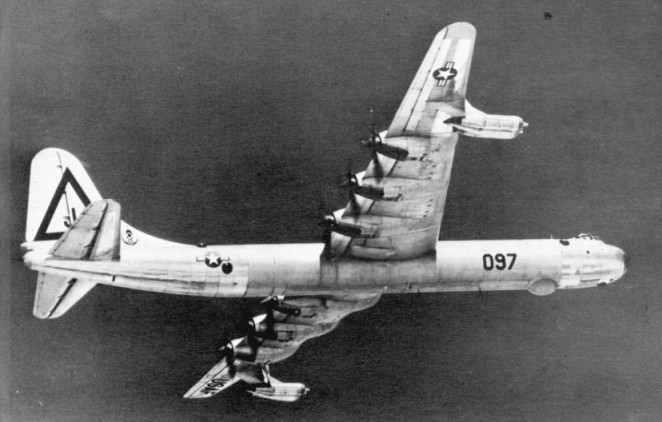
Originating from a design competition AFTER the Battle of Britain
and BEFORE Pearl Harbor ... this long range bomber was designed for
intercontinental missions, finally
entering service with the US Strategic Air
Command in June 1948. The air-cooled pusher propeller engines were
rated at 3000-3800 hp each and later models of the bomber included the
turbojet
engines shown.
It was best suited for bombing Europe from a distance (e.g. from a base
in Gander,
Newfoundland) ... if Britain and its air bases had been knocked out of
World War 2 by Germany. The bomber saw only slightly more than a decade
of Cold War service before it became obsolete. In 1948, it was the only
aircraft which could
carry the
comparatively unwieldy nuclear weapons of the time to the Soviet Union
... with a total bomb-load of 23 tons.
One was also modified to carry a
small working atomic reactor ... to assess whether military aircraft
could be powered by atoms to increase their range and endurance.
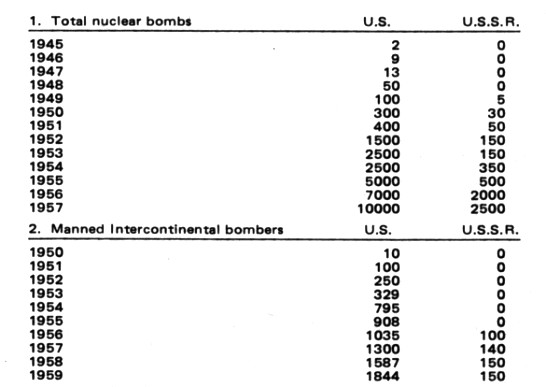
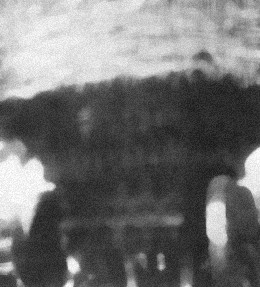 from 'Moral Principles and Nuclear
Weapons' Douglas P. Lackey, 1984
from 'Moral Principles and Nuclear
Weapons' Douglas P. Lackey, 1984
Thanks to Air Force lobbying and tradition, 'manned intercontinental
bombers'
... as were used to fight the last
world war ...
were initially the 'weapons of choice' for the United States.
In the US there was a well-established industry and they made good
aircraft, such as the B-52 ...
many of which, with extensive modifications, were still
flying 50 years later ...

If you had one of these Stratofortresses ... what could possibly scare
you?
Four years after Stalin's death ...
and a year after Stalin was denunciated by Khrushchev ...
... in 1957 ...
Those paradigm-shifting Soviets ... with little
domestic heavy aircraft industry profits to feed ...
opted for something more stylish and futuristic to demonstrate their
atomic manliness.
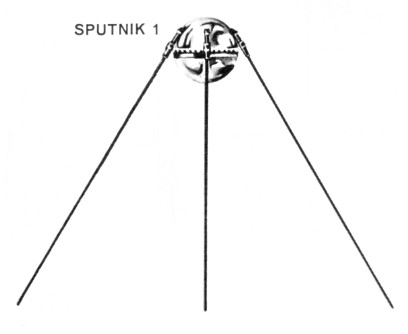
Very scary ... Sputnik 1 ... it beeps!
The first artificial object in earth orbit ...
Sputnik ('Fellow Traveller') 1 ... got there by riding the world's
first intercontinental ballistic missile.
With its sinister communist beeping it 'mooned' the USA about
every 90 minutes.
Overheard in the Eisenhower White
House the night Sputnik was launched ...
"Hello, Pentagon? ... White House here.
... how could we NOT know! ... all three TV networks are playing the
beep!
... say, might you have someone there who knows about 'rockets' ?
... Oh, yeah ... him.
... still smokes his cigarettes funny, fork in the wrong hand ?
Figured. His old salute is gone I hope.
... you're sure he's not
related to Hitler's girlfriend, though? ... good enough ...
OK, thanks buddy ... I'll give Disney a call next and see maybe if we
can 'Walt-wash' him again for the voters."
Citizens! ... Consumers! ...
We've been through the Great Depression ...
We've been through the most terrible war the world has seen ...
Now, let's finally enjoy the good
things of life !
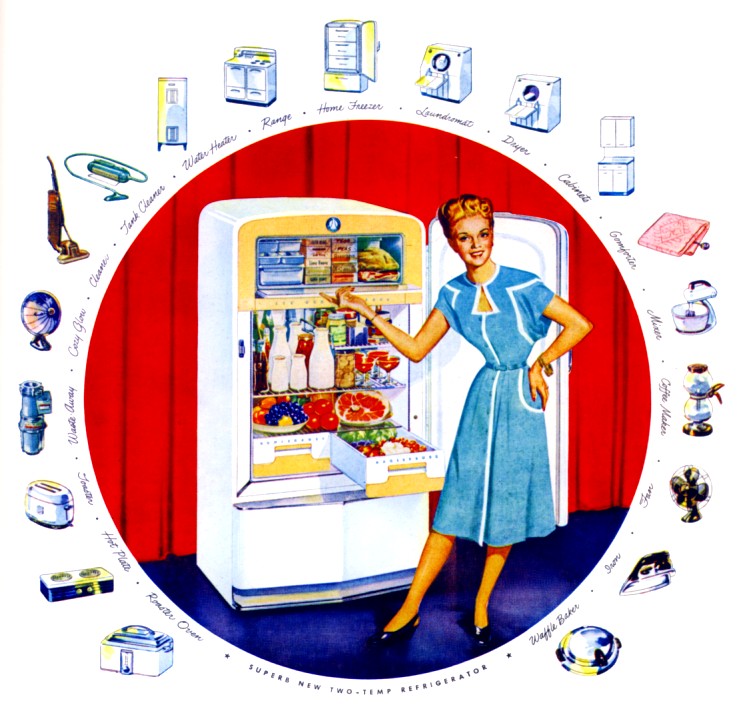 The explosion of consumer goods helped fuel the post-war
manufacturing economies of America and Canada.
These appliances all run on electricity ... and where's that going
to come from? ...
The explosion of consumer goods helped fuel the post-war
manufacturing economies of America and Canada.
These appliances all run on electricity ... and where's that going
to come from? ...
* * *
The Powered Future
(1954, US)
"No longer will
India have to remain
starved for the horsepower that is needed to run factories. Her 400
million people will have a chance to work, to raise themselves from
depths of hopeless poverty.
"Australia can have all the power she wants - enough to irrigate the
Great Victoria desert. Water, too, can be brought to the fertile soils
of the Sahara, to the dry plains of Southwest Africa.
"Arctic snows can be melted. Antarctica's rich mineral deposits can be
exploited. New industrial centers can be built in the wilds of North
Canada.
"Holland with no power resources except imported fuels sees uranium as
the cheapest answer yet to future needs.
"Britain figures atomic power is her best hope. In fewer than 30 years
coal output will not meet her power needs. She plans within 25 years to
fill more than half her requirements with nuclear reactors.
"Brazil thinks atomic power may be the least costly - and the quickest
- way for her to unlock her inland jungles.
"Atomic power plants may never be made so compact as to fit under the
hood of the family car, but 25-50 years from now - when world oil
reserves may have dwindled sharply, when gasoline supplies have
tightened - the atom may supply the energy needed to convert coal into
liquid fuels.
"By then the diesel locomotive will be obsolete, a curio like the steam
engine. By then atomic engines will haul the nation's trains, each unit
putting out many times the diesel's 1500 horsepower.
"By then, too, the world's navies, merchant fleets will run on uranium,
instead of coal and oil.
"The atom's place in the sky still is not clear. It may power bombers,
long range missiles or a few extra-large round-the-world airliners.
Too, it may provide man with the vast thrust he needs to break loose
from the earth's gravitational pull - to being his inevitable 'conquest
of the infinite'."

(image from 'The Book of the Atom, 1960, British)
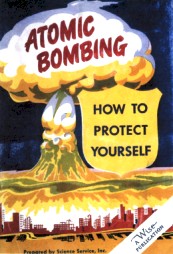 (1950, US)
(1950, US)
"After a war
must come peace. If we could break this chain in the future, the very
real conflicts between communism and democracy might be resolved
without the waste of devastating war. There would need to be
realization on both sides that, short of unthinkable annihilation of
all who differ with each other, the opponents must reconcile their
conflicts.
"This is the catch in the situation: We can control atoms so much more
effectively than men's minds and emotions, particularly human behavior
behind the iron curtain.
"If we can try to control human behavior, through the United Nations,
through as cool a war of ideas and words as possible, through
mobilization of world opinion, as well as marshalling of our military
strength, the falling of A-bombs may be prevented.
"If A-bombs fall, it will be another failure in our civilization - but
most of us will live on even through such a disaster."
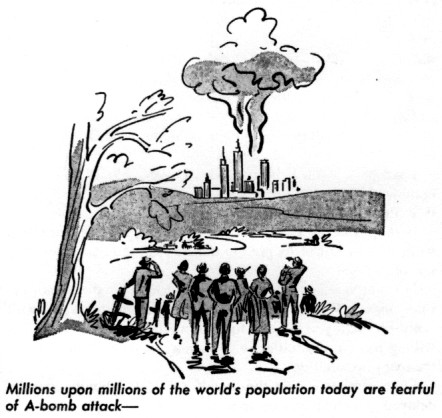
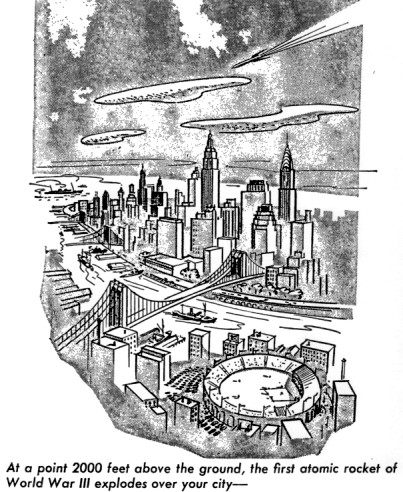 "WHAT AN A-BOMB WILL DO"
"WHAT AN A-BOMB WILL DO"
"Out of the sun a black,
cigar-shaped object falls toward the earth. At the edge of town a
filling station attendant sees it cross the slice of sky between the
car above him and the edge of his grease pit. The center fielder of the
visiting baseball team sees the moving spot, then looks back toward the
batter, impatient for the third out. A woman in the park hears a
strange, thin whistle and looks up, shading her eyes.
"At a point 2000 feet above the ground, the first atomic rocket of
World War III explodes over your city. In one vast flash of light,
equal to 100 suns, the buildings are etched against a sky of fire. A
blinding ball of flame leaps from the point where the rocket exploded.
"There, in a millionth of a second, a lump of plutonium or
uranium, perhaps the size of a basketball, disappears. As it vanishes,
the temperature at that point jumps to 1,000,000 degrees Centigrade.
The air around it is pushed outward by a pressure hundreds of thousands
times that of the normal pressure of the atmosphere.
"A thousandth of a second later, the ball of fire is 45 feet
across. Its temperature has dropped to 300,000 degrees.
"After a full second, there is a globe of flaming air 450 feet
wide, the size of a city block.
"The shadows cast by this ball of fire are etched permanently into
concrete sidewalks and granite buildings. Directly beneath the burst,
in the split second before the blast wave arrives, pedestrians simply
vanish into smoke and ash. This is the point which atomic scientists
call "ground zero". Here the sidewalk temperature is between 3,000 and
4,000 degrees.
"With the sheer flash heat comes another form of radiating energy,
the only one which a conventional high-explosives bomb cannot match on
its smaller scale: Nuclear radiation, X-rays of the A-bomb, invisible
yet striking through concrete and steel to destroy the single human
cells in bone marrow, blood and living tissues.
"Then the blast hits. A moving wall of shock crushes the city
under
a giant hand, wrenches it from it foundations, levels a mile-wide area
into rubble. Small masonry buildings are engulfed by a pressure wave
and collapse completely. Light buildings and homes are totally
demolished by the blast. Factories of steel are stripped of roofing and
siding. Only twisted skeletons remain, leaning away from ground zero as
though struck by a hurricane of stupendous proportions.
"When the shock and blinding heat have gone, fire springs up in
the wreckage. And billowing out in great clouds of dust, falling back
to earth from the towering mushroom of smoke, there is the hidden
terror which scientists call residual radioactivity."
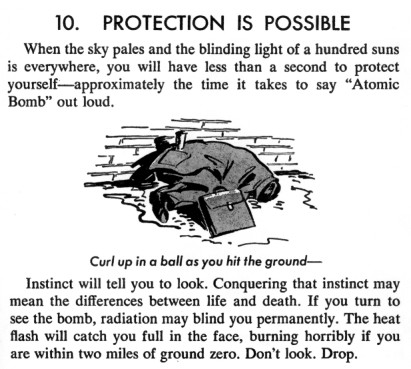 [Enjoying the new post-war quality of
life, sir?]
[Enjoying the new post-war quality of
life, sir?]
"ATOMIC
FORCES"
"When energy is
released suddenly by any sort of bomb, the rise in temperature of the
exploding materials causes complete vaporization of the bomb, casing
and all. Solid matter suddenly turns to gas.
"This gas is in a restricted space, pushing outward with high pressure
on the air around it. So great is this push that it can move air, water
or earth, whatever is around the bomb when it goes off. The series of
events which follow constitute the destructive blast of the bomb. In
TNT and atomic bomb alike, blast does nearly all the physical damage by
brute force. The tremendous heat generated by the explosion sends forth
energy in a second way, which the scientists call thermal radiation.
This is heat traveling with the speed of light, heat exactly like that
given off by the sun. The rays are not penetrating. They are stopped by
any object which stops light.
"Alone in the atomic bomb, rays of nuclear fission channel a third
explosion of energy. When the radioactive material of the bomb
disintegrates, it releases various particles of electricity: beta
particles, the atom's electrons; alpha particles, which are
combinations of neutrons and protons; neutrons alone, the particles
from the center of atoms; and finally gamma rays, which are high-energy
rays very similar to X-rays.
"The cumulative effect of these sources of energy is the measure of the
atomic bomb, or of any other explosion of nuclear force, whether it be
in the fission of uranium or the fusion of hydrogen in the 'Hell-bomb'."
This refrain may sound familiar to Canadian ears ...
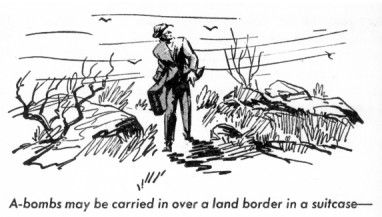
* * *
"The leaders of
organized religion in the United States are well aware of the tensions
and uncertainties of the times. The threat to our national security is
very real. Planning against possible disaster does not mean that war is
inevitable, but not to plan against it would be negligent folly. The
clergy and religions organizations of the country have a definite
responsibility to participate actively in such planning and should have
a comprehensive and organized role in civil defense in their
communities.
"While the spiritual resources of organized religion must be considered
in relation to the entire defense effort, the maintenance of the normal
offices and practice of religion will promote security and spiritual
composure for members of the different faiths in the present period of
tension. Interrelationships and loyalties within religious groups
provide stability and purpose for living in time of emotional stress
and uncertainties.
"Worship, preaching, religious rites, and the activities of religious
groups are especially helpful in preventing panic. In time of atomic or
other attack upon the Nation, the demand upon the religious resources
of the country would be unprecedented. The ministry of religious
institutions and bodies would be vital in helping families and
individuals to return to normal living following an enemy attack, thus strengthening the home front to carry on
until victory is achieved." [emphasis mine]
from 'The Clergy in Civil Defense'
(1951 US)
A novelty song which cleverly summarizes the development of atomic
weapons
and the post-war dilemma faced by the citizens of the world is ...
'Old Man Atom'
... "Einstein says he's scared, and when Einstein's scared, I'm scared"
Several versions are available on iTunes.
The 1950 interpretation by the Sons
of the Pioneers provides the most interesting mix of lyrics and
arrangement.
This version of the 1946 song
is fascinating as a 'historical artifact' for another reason.
It's composer was Vern Partlow, a reporter with the "Daily News" of Los
Angeles.
The idea came to him after repeated assignments to interview atomic
scientists after the war, who had come to LA to speak.
Those campaigning against communism around 1950 ...
at the time of the United Nations sponsored Korean War, and just after the Revolution in China ...
complained loudly that the 'new' song promoted a contemporary Communist 'peace' message.
RCA Victor self-censored by pulling the Sons of the Pioneers version in
spite of the fact
that theirs, and other versions, were very popular at the time.
There were numerous editorial complaints in newspapers about the
withdrawal of the song,
but it disappeared until revived by others in the 1960s.
Partlow was blacklisted.
The late 1950s
& early 1960s in 'MAD Magazine'
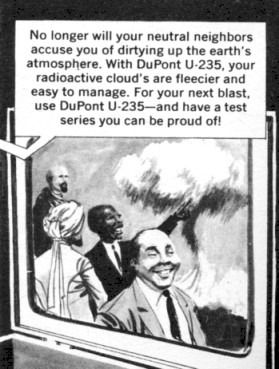
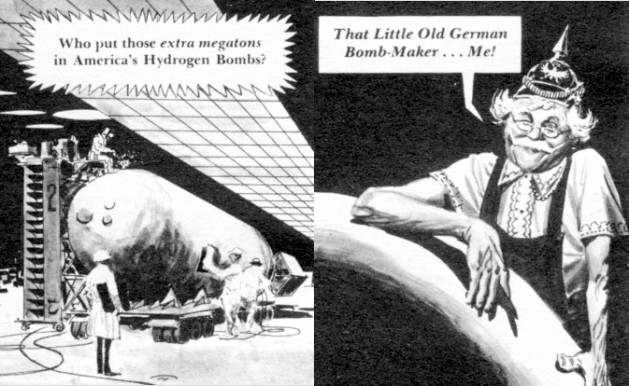
Wernher von Braun and other Nazi Wehrmacht military rocket scientists
and technicians ...
and as much technology as could be carted out of Europe before the
Soviets arrived ...
formed the nucleus of the American space ... and nuclear missile
programs.
At Huntsville, Alabama, with von Braun and his crew
the Americans started experimenting with the very V2 rockets which had
been launched on Britain.
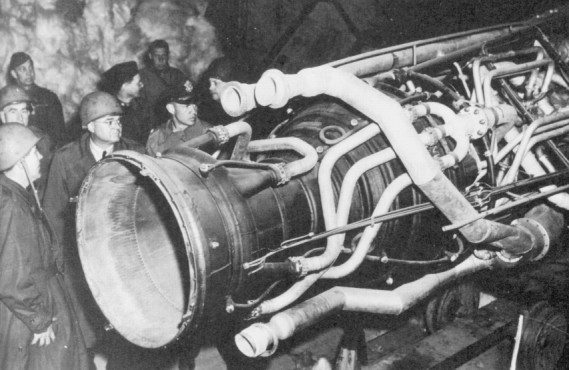 Just after the German surrender ...
A US congressional delegation inspects
the two, mile long underground tunnels
Just after the German surrender ...
A US congressional delegation inspects
the two, mile long underground tunnels
where V2 rockets were built by
concentration camp inmates.
This was at Nordhausen in central
Germany ... part of the Buchenwald 'family' of camps near Weimar.
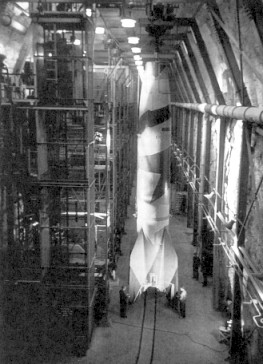 Late in World War 2
Late in World War 2
British and American bombing raids on Germany,
by night and by day respectively,
drove essential production (including
V2's) underground
... and with Albert Speer directing these changes production
actually went up!
 Wernher von Braun (shown in 1958) was
the engineer and physicist who ran the German V
Wernher von Braun (shown in 1958) was
the engineer and physicist who ran the German V (Vergeltungswaffe,
Vengeance weapon)
rocket program.
Although primarily an enthusiastic
and
talented rocket geek ... who later designed US ICBMs,
and the great
Saturn V moon rocket ...
he had also been an officer in the SS
through all of World War 2 and had visited the Mittlebau-Dora V2
assembly facility ...
where the V2 rockets had been built by concentration camp slave labour
- featuring summary executions, etc.
1960s
When you've got a new hammer ... every problem begins to look like a
nail.
"Excavation for Water Conveyance with Nuclear Explosives"
[A paper from the
proceedings of the third Plowshare Symposium, April 1964]
"They will beat their swords
into ploughshares and their spears into pruning hooks.
Nation will not take up sword against
nation, nor will they train for war anymore."
"The California Department of Water
Resources is charged with a continuous study program for the future
development of water resources throughout the State. The Atomic Energy
Commission, through its Plowshare Program, is responsible for
investigation and developing industrial uses for nuclear explosives.
The West Side Conveyance System is a possible feature of future work
for conveyance of water from the North Coastal area to areas of
efficiency. Joint reconnaissance studies of this possible feature
indicates substantial savings in cost may be possible if nuclear
explosives can be used for excavation. Further studies are proposed for
evaluation of hazards and engineering feasibility."
[The diagram above
shows both conventional and nuclear elements of the possible project.
For reference: The bombs dropped on Japan yielded about 20KT or less]
"Conclusions:
1. It is technically and
structurally feasible to construct water conveyance channels, in the
Cretaceous formation of western Tehama County, by nuclear means.
2. Based upon current knowledge and a reasonable projection of
knowledge expected to be developed prior to the contemplated time of
possible construction (perhaps about 1985 or 1990), it would be
possible to detonate the nuclear devices with safety.
3. Radioactive contamination of water flowing through the excavated
channels, or in ground water, would be far less than the level of
tolerance.
4. It may be possible to make significant savings in overall cost of
the System. "
From a 1969 textbook ... here is how
'common' uranium eventually turns into lead.
Another problem with nuclear power generation.

Nuclear Waste Problem #2
... as you remember from the last page ...
the atoms of U-235 in a fission reaction get smashed up into a number
of different radioactive elements.
Then ... each SINGLE unstable
radioactive product of a fission reaction ... has its OWN decay chain.
The particular 'uranium-238 to lead' decay chain above has a HALF-LIFE of about 4.5 billion years.
This means ... after you have patiently waited 4.5 billion years
...
the other half of the
radioactive atoms in your sample
will still be pinballing their way down the chain to lead.
Well at least North America is now safe
and we are enjoying peace and post-war prosperity ...
 '10 For Survival' (US 1959)
'10 For Survival' (US 1959)
[Canada's booklet is better
- see below - '11 Steps to Survival']
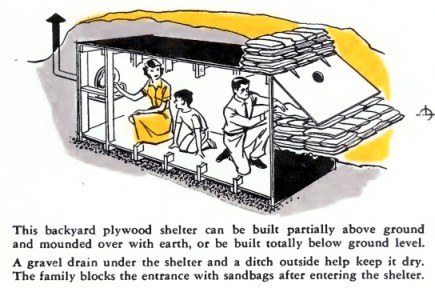 ... and must live there for at
least a couple of weeks.
... and must live there for at
least a couple of weeks.
Don't forget drinking water and the bucket for 'you know what'.
'Fallout Protection' (US 1960)
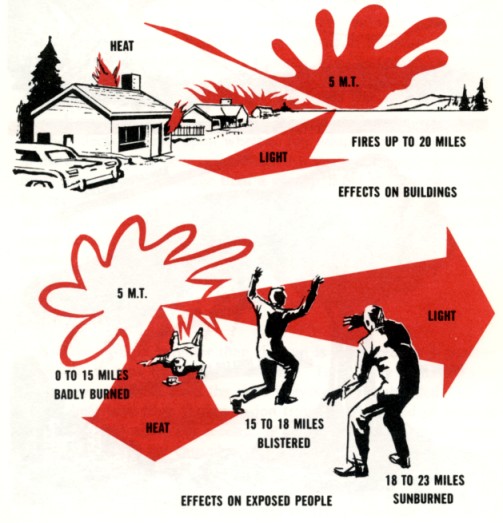 '11 Steps to Survival'
(Canada 1971)
'11 Steps to Survival'
(Canada 1971)
By the early 1960s, with the much more destructive Hydrogen Bomb
available in quantity on both sides ...
(from 1 up to 25 megatons for 'strategic' - i.e. 'city' - bombs)
and with Soviet missile targetting accuracy greatly improved ...
urban civil defense efforts in preparation for an attack were futile ...
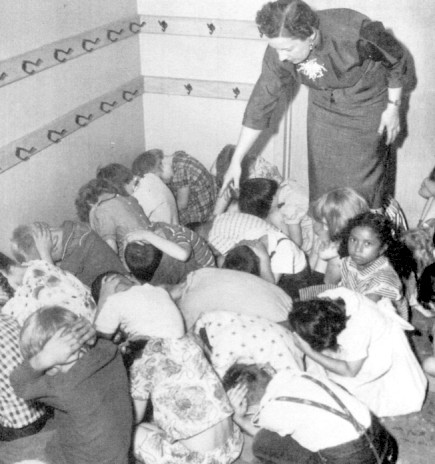
Making good hopeful citizens of Canadian kindergarten kids in 1954.
Before big H-bombs became just so darned popular.
Back in the early days of the
'Atomic Age' when Civil Defense
was promoted, the influences of World War 2 were fresh in the minds of
planners. Bomb shelters could provide good blast protection ... and a
massive
evacuation of a city on short notice would clog the roads, making
military and emergency vehicle passage impossible. In addition,
maintaining basic city services and 'wartime production' ... key in
Britain during the prolonged 'Blitz' ... were only possible if people
didn't 'take to the hills'.
Some circa 1950 US Civil Defense films describe the 'take to the hills
fraternity' as being
'almost treasonous'. Afterwards, these people will always have to live
with the fact that 'they let their family, their friends, their city
... down'. 'America's cities must fight!'
In fact, during World War 2, cities in which large firestorms had
developed (Dresden, Hamburg, Tokyo) were very unhealthy places to be.
Oxygen was consumed by the fires, causing suffocation of those citizens
who were otherwise safe from injury in deep bomb shelters. The heat of
huge fires also killed. For example, intense heat melted asphalt ...
trapping people trying to flee down the streets like fly paper, or,
like those terrible
mouse glue traps ... to give a more modern reference.
During the early atom bomb days, you might survive using World War 2
techniques supplemented by the
special knowledge developed from the
experiences of those killed and injured at Hiroshima and Nagasaki.
Primarily: duck under structural protection, protect the head and neck
from
debris, cover exposed skin to protect it from flash burns.
Once hydrogen bombs were developed ... those living in large cities,
and
receiving a 30 minute warning ... would have to depend on exceptionally
good luck.
The Good Old Days of Atomic Bombs
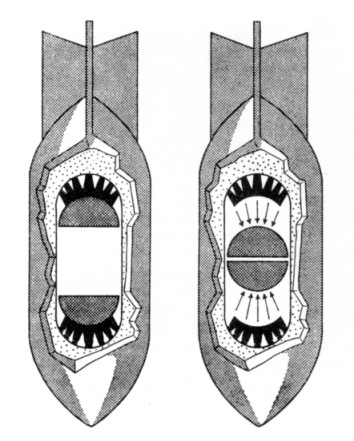
In this cartoon of an atomic
bomb ... you can see explosive charges forcing a mass of uranium 235 or
plutonium together.
The charge becomes 'super-critical' (explosive) because 'split atom
products' with tremendous energy ... in turn ...
split more and more atoms at
an exponential rate.
However, the size (power) of an atomic bomb is limited because there is
only so much atomic fuel you can bring together ...
before it goes supercritical right there on your workbench, or within
the bomb casing.
During the Manhattan Project work, the concept of a 'Super' was
discussed.
It would use more powerful atomic fusion
... instead of fission ... as the main explosive process.
With an H-bomb:
A radioactive fission
'primary'
would be needed to set off the 'secondary'
...
a fusion reaction of 'heavy
hydrogen' (deuterium or tritium).
A small fission charge would be plenty
to produce the needed high energy neutrons ...
but it unfortunately also made everything radioactive after the blast.
Happily, the designers could use all
the hydrogen they wanted to make the explosion much larger.
There was no limit ... as
there was with uranium/plutonium 'atomic weapons'.
World War
II atomic bomb - about
20,000 tons of TNT
'World War III' hydrogen
bomb - up to 25,000,000 tons of TNT
|
* * *
Here is an old and grainy simulation of a
1,000,000 tons of TNT (1 megaton) nuclear airburst over New York.
For scale, the black arrow points to the World Trade Center.
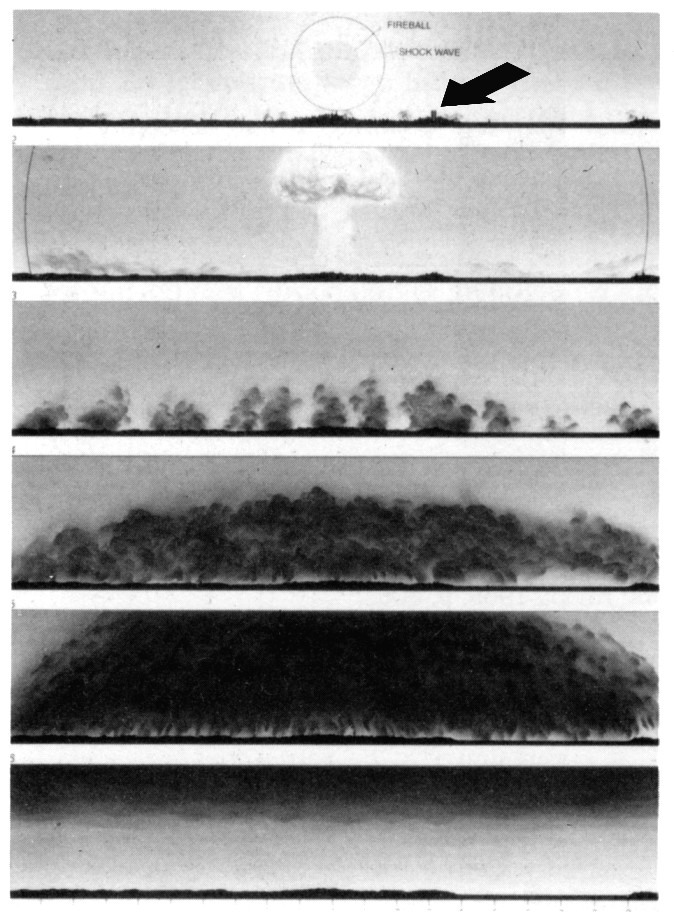
With greenhouse gas global warming, we have quickly forgotten about the
good old days of 'Nuclear Winter'.
This unintended consequence of nuclear war was communicated to us
rather late ...
about THIRTY YEARS after humans had the megatonnage to achieve it.
The idea was that maybe 100 nuclear detonations of the type shown above
(1 megaton)
would throw enough smoke and opaque debris high into the atmosphere ... so that
...
The sun would probably disappear for a year or more,
the weather would get much cooler,
much of earth's natural flora and fauna would be affected,
and crops would fail.
Starvation, and elimination of any still-surviving human civilization would be the
general result.
You could still have isolated 'Mad Max "civilizations" ' somewhere ...
But if you define 'civilization' as ...
books from Amazon delivered to your door ...
Facebook ...
arthroscopic knee surgery ...
Starbucks ...
prescription pharmaceuticals ...
mutual funds and pensions ...
air travel ...
... and functioning systems to provide ...
petroleum products, hydro-electricity, clean piped water, sewers ...
After a large nuclear exchange ... followed by 'nuclear winter' ...
civilization would be gone.
